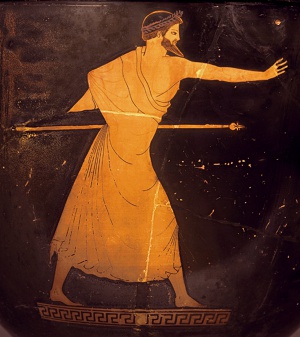Zeus (mythology): Difference between revisions
From BoyWiki
Modified the introduction of the article |
Modified two internal links |
||
| Line 1: | Line 1: | ||
[[File:BERLIN PAINTER -495c Zeus holding a scepter (Louvre G175) 1234x1388.jpg|thumb|Zeus holding a scepter from a red-figure bell Krater depicting Ganymede and Zeus<ref>http://www.louvre.fr/en/oeuvre-notices/attic-red-figure-bell-krater</ref><BR> (see [[Trochus/Hoop]])]] | [[File:BERLIN PAINTER -495c Zeus holding a scepter (Louvre G175) 1234x1388.jpg|thumb|Zeus holding a scepter from a red-figure bell Krater depicting Ganymede and Zeus<ref>http://www.louvre.fr/en/oeuvre-notices/attic-red-figure-bell-krater</ref><BR> (see [[Trochus/Hoop]])]] | ||
'''Zeus''' (/zjuːs/; Ancient Greek: Ζεύς <i>Zeús</i> [zdeǔ̯s]), in [[ancient | '''Zeus''' (/zjuːs/; Ancient Greek: Ζεύς <i>Zeús</i> [zdeǔ̯s]), in [[ancient Greece|Greek]] mythology, was the god of the sky, thunder, lightning, order, law and justice. He ruled over the gods and resided with them on the summit of Mount Olympus. In Latin his name is Jupiter. He played an important role in a great quantity of ancient Greek myths, one of the most notable being his abduction of [[Ganymede (mythology)|Ganymede]]. | ||
==Relationship with [[Ganymede]]== | ==Relationship with [[Ganymede]]== | ||
Revision as of 05:29, 5 October 2019

(see Trochus/Hoop)
Zeus (/zjuːs/; Ancient Greek: Ζεύς Zeús [zdeǔ̯s]), in Greek mythology, was the god of the sky, thunder, lightning, order, law and justice. He ruled over the gods and resided with them on the summit of Mount Olympus. In Latin his name is Jupiter. He played an important role in a great quantity of ancient Greek myths, one of the most notable being his abduction of Ganymede.
Relationship with Ganymede
While the relationship between Zeus and Ganymede is often not described as overtly pederastic, it is believed by many to be so.[2][3][4][5] In the myth, Zeus transformed himself into an eagle and abducted the beautiful youth Ganymede for him to serve as his wine boy.
See also
References
- ↑ http://www.louvre.fr/en/oeuvre-notices/attic-red-figure-bell-krater
- ↑ "Boy-love is a delight, since even the son of Kronos, King of the gods, once came to love Ganymede, And seizing him, brought him up to Olympus and made him Eternal in the lovely flower of boyhood." (Theognis, 1346-49).
- ↑ "The Chalkidians of Euboia are ... especially fond of love with boys... [and] say that Ganymede was stolen from their very own territory [by Zeus]." (Athenaios 13.601)
- ↑ "Sophokles in 'Women of Colchis' says of Ganymede that he 'lit the fire of tyrant Zeus with his thighs.'" (Athenaios 13.602)
- ↑ "After the lover has spent some time doing this, staying near the boy (and even touching him during sports and on other occasions), then the spring that feeds the stream Zeus named 'Desire' when he was in love with Ganymede begins to flow mightily in the lover and is partly absorbed by him." (Plato, Phaedros, 255).
